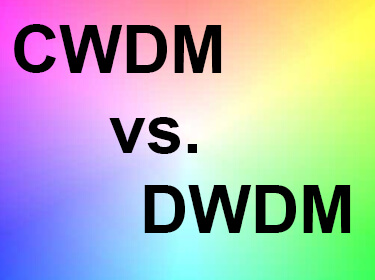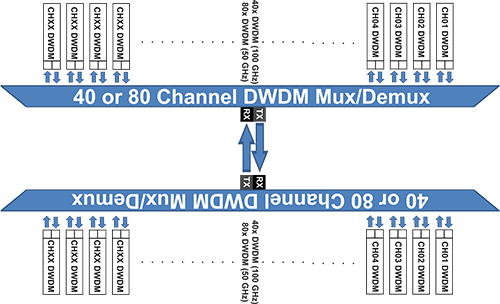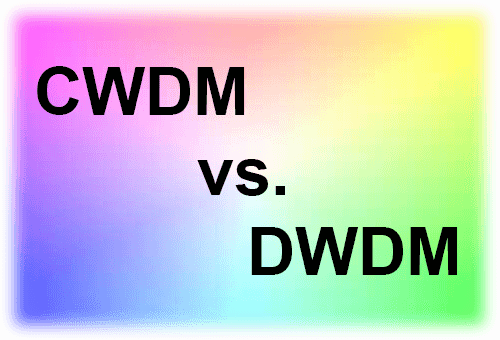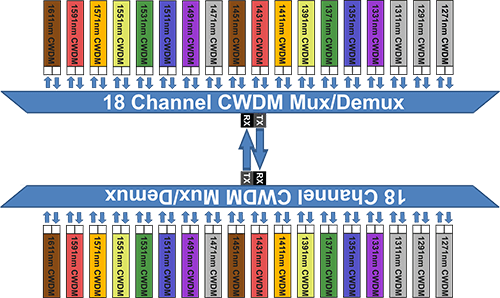
What is DWDM?
DWDM is a shortening Dense Wavelength Division Multiplexing. DWDM as an optical transmission technology has evolved after the previous SONET/SDH technology has reached its limitations in terms of ecosystem components to achieve price competitive high data rates transmissions over the fibers.
The basic unit for data rate transmitted over such a system was OC3 or STM-1 consisting in 155 Mbs.The highest rate commonly deployed is the OC-768 or STM-256 circuit, which operates at rate of just under 38.5 Gbit/s. The combination of early lasers sources and electronic circuitry transmitting on 1310 nm on single mode fibers ,with the method of obtaining higher signals by time-division multiplexing to form the next level of the SONET hierarchy, has reached the fiber bandwidth exhaustion

The Development of WDM
WDM technology has changed the way that data streams are launched on the fiber. The development of optoelectronic components has allowed to transmit simultaneous parallel light waveguides on the fiber expanding the total bandwidth of a transmission system. Multiple high-bit rate data streams of 2.5 Gb/s, 10 Gb/s and, more recently, 40 Gb/s and 100Gb/s could be multiplexed through divisions of several wavelengths. And so was born Wavelength Division Multiplexing (WDM).
DWDM - system components require higher precision in fabrication and operation thus making the overall price of the system higher than the CWDM - Coarse Wavelength Division Multiplexing which appeared later as an cheaper alternative for shorter distances and few lambdas to be transmitted.


CWDM / DWDM - The Differences
1. DWDM uses frequencies standardisations, the ITU-T G.694.1 frequency grid to address each channel transmitted over fiber, these frequencies are much more ‘dense’ and more tightly spaced than CWDM. CWDM uses lambdas to refer to its transmission guides and the ITU standardized a channel spacing grid for use with CWDM (ITU-T G.694.2).
2. Analysing and comparing the signals on the fiber it may be observed the wider band signals of CWDM and larger spaces between lambdas having a greater tolerance to frequency shifting. Multiplexing and demultiplexing of channels can be achieved with components at reasonable prices. In DWDM systems, narrow frequencies and tightly packed transmission on the line requires precision filters, cooled lasers and dispersion compensators. The "drift" off a very narrow frequency window of the order of a few GHz, creates performance degradation which is very demanding task trying fixing.

3. DWDM system can reach distances of thousands of kilometers with the combination of Erbium Doped Fibre Amplifier or Raman Amplifiers on single mode fibers. CWDM distances are up to tens of kilometers without the use of optical amplifiers that may be adequate for metro carriers who prefer to start small and expand later as demand increases.
4. OSC- Optical Supervision Channel is a system component specific only for DWDM implementations. It consists in a separate optical channel. This is data channel which uses an additional wavelength usually outside the EDFA amplification band (at 1,510 nm, 1,620 nm, 1,310 nm or other proprietary wavelength). The OSC carries information about the multi-wavelength optical signal as well as remote conditions at the optical terminal or EDFA site. It is also normally used for remote software upgrades and Network Management information.
Summary:
|
CWDM |
DWDM |
|
Defined by wavelengths |
Defined by frequencies |
|
Short-range communications |
Long-haul transmissions |
|
Uses wide-range frequencies |
Narrow frequencies |
|
Wavelengths spread far apart |
Tightly packed wavelengths |
|
Wavelength drift is possible |
Precision lasers required to keep channels on target |
|
Breaks the spectrum into big chunks |
Dices the spectrum into small pieces |
|
Light signal isn't amplified |
Signal amplification may be used |
|
Entry level price |
Expensive price systems |
 Deutsch
Deutsch
 English
English
 Espaniol
Espaniol










